Lifestyle changes in women with polycystic ovary syndrome
- PMID: 30921477
- PMCID: PMC6438659
- DOI: 10.1002/14651858.CD007506.pub4
Lifestyle changes in women with polycystic ovary syndrome
Abstract
Background: Polycystic ovary syndrome (PCOS) affects 8% to 13% of reproductive-aged women and is associated with reproductive and metabolic dysfunction. Obesity worsens the presentation of PCOS and weight management (weight loss, maintenance or prevention of excess weight gain) is proposed as an initial treatment strategy, best achieved through lifestyle changes incorporating diet, exercise and behavioural interventions.
Objectives: To assess the effectiveness of lifestyle treatment in improving reproductive, anthropometric (weight and body composition), metabolic and quality of life factors in PCOS.
Search methods: We searched the Cochrane Gynaecology and Fertility Specialised Register, the Cochrane Central Register of Controlled Trials (CENTRAL), MEDLINE, Embase, PsycINFO, CINAHL and AMED (date of last search March 2018). We also searched controlled trials registries, conference abstracts, relevant journals, reference lists of relevant papers and reviews, and grey literature databases, with no language restrictions applied.
Selection criteria: Randomised controlled trials (RCTs) comparing lifestyle treatment (diet, exercise, behavioural or combined treatments) to minimal or no treatment in women with PCOS.
Data collection and analysis: Two authors independently selected trials, assessed evidence quality and risk of bias, and extracted data. Our primary outcomes were live birth, miscarriage and pregnancy. We used inverse variance and fixed-effect models in the meta-analyses. We reported dichotomous outcomes as an odds ratio and continuous outcomes as a mean difference (MD) or standardised mean difference (SMD).
Main results: We included 15 studies with 498 participants. Ten studies compared physical activity to minimal dietary and behavioural intervention or no intervention. Five studies compared combined dietary, exercise and behavioural intervention to minimal intervention. One study compared behavioural intervention to minimal intervention. Risk of bias varied: eight studies had adequate sequence generation, seven had adequate clinician or outcome assessor blinding, seven had adequate allocation concealment, six had complete outcome data and six were free of selective reporting. No studies assessed the fertility primary outcomes of live birth or miscarriage. No studies reported the secondary reproductive outcome of menstrual regularity, as defined in this review.Lifestyle intervention may improve a secondary (endocrine) reproductive outcome, the free androgen index (FAI) (MD -1.11, 95% confidence interval (CI) -1.96 to -0.26, 6 RCTs, N = 204, I2 = 71%, low-quality evidence). Lifestyle intervention may reduce weight (kg) (MD -1.68 kg, 95% CI -2.66 to -0.70, 9 RCTs, N = 353, I2 = 47%, low-quality evidence). Lifestyle intervention may reduce body mass index (BMI) (kg/m2) (-0.34 kg/m2, 95% CI -0.68 to -0.01, 12 RCTs, N = 434, I2= 0%, low-quality evidence). We are uncertain of the effect of lifestyle intervention on glucose tolerance (glucose outcomes in oral glucose tolerance test) (mmol/L/minute) (SMD -0.02, 95% CI -0.38 to 0.33, 3 RCTs, N = 121, I2 = 0%, low-quality evidence).
Authors' conclusions: Lifestyle intervention may improve the free androgen index (FAI), weight and BMI in women with PCOS. We are uncertain of the effect of lifestyle intervention on glucose tolerance. There were no studies that looked at the effect of lifestyle intervention on live birth, miscarriage or menstrual regularity. Most studies in this review were of low quality mainly due to high or unclear risk of bias across most domains and high heterogeneity for the FAI outcome.
Conflict of interest statement
SL received a National Health and Medical Research Council (NHMRC) fellowship in support of this work. SL has received reimbursement from the Endocrine Society of Australia to present at an endocrinology conference.
EVR has nothing to disclose.
SKH received Sabbatical Support from Monash Health in support of this work. SKH currently works as a clinician in an Australian public hospital PCOS clinic. SKH has received travel grants to attend PCOS conferences from the Endocrine Society of Australia, NHMRC, the Australian Diabetes Society and the PCOS International Guideline Development Group from the PCOS Centre for Research Excellence.
HJT receive partial or complete salary funding from NHMRC.
LJM received salary funding from the Heart Foundation of Australia. LJM has received reimbursement from the Heart Foundation of Australia to attend endocrinology and PCOS conferences.
RJN has received grants and honoraria from Schering Plough, Merck Serono and Ferring Pharmaceuticals.
LJM and RJN are previous investigators of studies examining weight loss through dietary intervention on reproductive and metabolic outcomes in polycystic ovary syndrome.
Figures

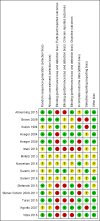
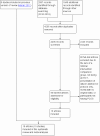

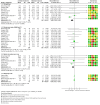

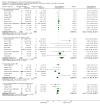
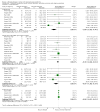


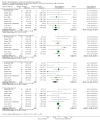



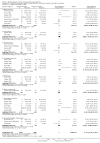
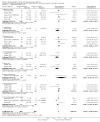
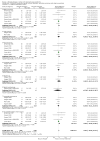




Update of
-
Lifestyle changes in women with polycystic ovary syndrome.Cochrane Database Syst Rev. 2011 Jul 6;(7):CD007506. doi: 10.1002/14651858.CD007506.pub3. Cochrane Database Syst Rev. 2011. Update in: Cochrane Database Syst Rev. 2019 Mar 28;3:CD007506. doi: 10.1002/14651858.CD007506.pub4. PMID: 21735412 Updated.
References
References to studies included in this review
Almenning 2015 {published and unpublished data}
Brown 2009 {published and unpublished data}
Guzick 1994 {published data only (unpublished sought but not used)}
-
- Guzick DS, Wing R, Smith D, Berga SL, Winters SJ. Endocrine consequences of weight loss in obese, hyperandrogenic, anovulatory women. Fertility and Sterility 1994;61(4):598‐604. - PubMed
Hoeger 2004 {published and unpublished data}
-
- Hoeger KM, Kochman L, Wixom N, Craig K, Miller RK, Guzick DS. A randomized, 48‐week, placebo‐controlled trial of intensive lifestyle modification and/or metformin therapy in overweight women with polycystic ovary syndrome: a pilot study. Fertility and Sterility 2004;82(2):421‐9. - PubMed
Hoeger 2008 {published and unpublished data}
-
- Hoeger K, Davidson K, Kochman L, Cherry T, Kopin L, Guzick DS. The impact of metformin, oral contraceptives, and lifestyle modification on polycystic ovary syndrome in obese adolescent women in two randomized, placebo‐controlled clinical trials. Journal of Clinical Endocrinology and Metabolism 2008;93(11):4299‐306. - PMC - PubMed
Mani 2018 {published data only}
Mirfeizi 2013 {published data only}
-
- Mirfeizi M. Comparison of effects of diet and exercise program to improve clinical symptoms and laboratory tests in obese women with polycystic ovary syndrome (PCOS). Medical Journal of Mashhad University of Medical Sciences 2013;56(2):77‐84.
Nasrekani 2016 {published data only}
-
- Nasrekani ZA, Fathi M. Efficacy of 12 weeks aerobic training on body composition, aerobic power and some women‐hormones in polycystic ovary syndrome infertile women. Iranian Journal of Obstetrics, Gynecology and Infertility 2016;19(5):1‐10.
Saremi 2013 {published and unpublished data}
-
- Saremi A, Nader, Karmali M, Kazemi M. Serum level of anti‐mullerian hormone after exercise training in women with polycystic ovary syndrome: a randomised controlled trial. Iranian Journal of Obstetrics, Gynecology and Infertility 2013;16(64):10.
Saremi 2016 {published and unpublished data}
-
- Saremi A, Yaghoubi MS. Effect of resistance exercises with calcium consumption on level of anti‐mullerian hormone and some metabolic indices in women with polycystic ovarian syndrome. Iranian Journal of Obstetrics, Gynecology and Infertility 2016;18(180):7‐15.
Stefanaki 2015 {published and unpublished data}
-
- Stefanaki C, Bacopoulou F, Livadas S, Kandaraki A, Karacalios A, Chrousos G, et al. Impact of a mindfulness stress management program on stress, anxiety, depression and quality of life in women with polycystic ovary syndrome: a randomised controlled trial. Stress (Amsterdam, Netherlands) 2015;18(1):57‐66. - PubMed
Stener‐Victorin 2009‐2013 {published and unpublished data}
-
- Jedel E, Labrie F, Oden A, Holm G, Nilsson L, Janson PO, et al. Impact of electro‐acupuncture and physical exercise on hyperandrogenism and oligo/amenorrhea in women with polycystic ovary syndrome: a randomised controlled trial. American Journal of Physiology‐Endocrinology and Metabolism 2011;300(1):E37‐45. - PubMed
-
- Leonhardt H, Hellstrom M, Gull B, Lind AK, Nilsson L, Janson OP, et al. Serum anti‐Mullerian hormone and ovarian morphology assessed by magnetic resonance imaging in response to acupuncture and exercise in women with polycystic ovary syndrome: secondary analyses of a randomized controlled trial. Acta Obstetricia et Gynecologica Scandinavica 2015;94:279‐87. - PubMed
-
- Stener‐Victorin E, Baghaei F, Holm G, Janson PO, Olivecrona G, Lönn M, et al. Effects of acupuncture and exercise on insulin sensitivity, adipose tissue characteristics, and markers of coagulation and fibrinolysis in women with polycystic ovary syndrome: secondary analyses of a randomized controlled trial. Fertility and Sterility 2012;97(2):501‐8. - PubMed
-
- Stener‐Victorin E, Holm G, Janson PO, Gustafson D, Waern M. Acupuncture and physical exercise for affective symptoms and health‐related quality of life in polycystic ovary syndrome: secondary analysis from a randomized controlled trial. BMC Complementary and Alternative Medicine 2013;13:131. - PMC - PubMed
-
- Stener‐Victorin E, Jedel E, Janson PO, Sverrisdottir YB. Low‐frequency electroacupuncture and physical exercise decrease high muscle sympathetic nerve activity in polycystic ovary syndrome. American Journal of Physiology ‐ Regulatory, Integrative and Comparative Physiology 2009;297(2):R387‐95. - PubMed
Turan 2015 {published and unpublished data}
Vigorito 2007 {published and unpublished data}
-
- Vigorito C, Giallauria F, Palomba S, Cascella T, Manguso F, Lucci R, et al. Beneficial effects of a three‐month structured exercise training program on cardiopulmonary functional capacity in young women with polycystic ovary syndrome. Journal of Clinical Endocrinology and Metabolism 2007;92(4):1379‐84. - PubMed
References to studies excluded from this review
Asemi 2015 {published data only}
-
- Asemi Z, Esmaillzadeh A. DASH diet, insulin resistance, and serum hs‐CRP in polycystic ovary syndrome: a randomized controlled clinical trial. Hormone and Metabolic Research 2015;47(3):232‐8. - PubMed
Atiomo 2009 {published data only}
-
- Atiomo W, Read A, Golding M, Silcocks P, Razali N, Sarkar S, et al. Local recruitment experience in a study comparing the effectiveness of a low glycaemic index diet with a low calorie healthy eating approach at achieving weight loss and reducing the risk of endometrial cancer in women with polycystic ovary syndrome (PCOS). Contemporary Clinical Trials 2009;30(5):451‐6. - PubMed
Azadi‐Yazdi 2017 {published data only}
-
- Azadi‐Yazdi M, Karimi‐Zarchi M, Salehi‐Abargouei A, Fallahzadeh H, Nadjarzadeh A. Effects of Dietary Approach to Stop Hypertension diet on androgens, antioxidant status and body composition in overweight and obese women with polycystic ovary syndrome: a randomised controlled trial. Journal of Human Nutrition and Dietetics 2017;30(3):275‐83. - PubMed
Beena 2016 {published data only}
-
- Beena MR, Thomas Kochuthressiamma. Outcome of interventional programme on quality of life of infertile women with polycystic ovarian syndrome. International Journal of Nursing Education 2016;8(2):27‐33.
Bruner 2006 {published data only}
-
- Bruner B, Chad K, Chizen D. Effects of exercise and nutritional counseling in women with polycystic ovary syndrome. Applied Physiology, Nutrition, and Metabolism 2006;31(4):384‐91. - PubMed
Curi 2012 {published data only}
-
- Curi DD, Fonseca AM, Marcondes JA, Almeida JA, Bagnoli VR, Soares JM Jr, et al. Metformin versus lifestyle changes in treating women with polycystic ovary syndrome. Gynecological Endocrinology 2012;28(3):182‐5. - PubMed
Ebrahimi 2014 {published data only}
-
- Ebrahimi‐Mamaghani M, Saghafi‐Asl M, Pirouzpanah S, Asghari‐Jafarabadi M. Effects of raw red onion consumption on metabolic features in overweight or obese women with polycystic ovary syndrome: a randomized controlled clinical trial. Journal of Obstetrics and Gynaecology Research 2014;40(4):1067‐76. - PubMed
Foroozanfard 2017 {published data only}
-
- Foroozanfard F, Rafiei H, Samimi M, Gilasi HR, Gorjizadeh R, Heidar Z, et al. The effects of dietary approaches to stop hypertension diet on weight loss, anti‐Müllerian hormone and metabolic profiles in women with polycystic ovary syndrome: a randomized clinical trial. Clinical Endocrinology 2017;87(1):51‐8. - PubMed
Fux Otta 2010 {published data only}
-
- Fux Otta C, Wior M, Iraci GS, Kaplan R, Torres D, Gaido MI, et al. Clinical, metabolic, and endocrine parameters in response to metformin and lifestyle intervention in women with polycystic ovary syndrome: a randomized, double‐blind, and placebo control trial. Gynecological Endocrinology 2010;26(3):173‐8. - PubMed
Giallauria 2008 {published data only}
-
- Giallauria F, Palomba S, Maresca L, Vuolo L, Tafuri D, Lombardi AM, et al. Exercise training improves autonomic function and inflammatory pattern in women with polycystic ovary syndrome. Clinical Endocrinology 2008;69(5):792‐8. - PubMed
Glueck 2006 {published data only}
-
- Glueck CJ, Aregawi D, Winiarska M, Agloria M, Luo G, Sieve L, et al. Metformin‐diet ameliorates coronary heart disease risk factors and facilitates resumption of regular menses in adolescents with polycystic ovary syndrome. Journal of Pediatric Endocrinology and Metabolism 2006;19(6):831‐42. - PubMed
Gower 2015 {published data only}
Hamayeli 2010 {published data only}
-
- Hamayeli Mehrabani H, Tahbaz F, Salehpour S, Hedayati M, Amiri Z, Ghassemi A. Reproductive hormonal changes following two types of hypocaloric diets in overweight and obese polycystic ovary syndrome women. Iranian Journal of Endocrinology and Metabolism 2010;12(2):160‐200.
Hutchison 2012 {published data only}
-
- Hutchison SK, Teede HJ, Rachon D, Harrison CL, Strauss BJ, Stepto NK. Effect of exercise training on insulin sensitivity, mitochondria and computed tomography muscle attenuation in overweight women with and without polycystic ovary syndrome. Diabetologia 2012;55(5):1424‐34. - PubMed
Jakubowicz 2013 {published data only}
-
- Jakubowicz D, Barnea M, Wainstein J, Froy O. Effects of caloric intake timing on insulin resistance and hyperandrogenism in lean women with polycystic ovary syndrome. Clinical Science 2013;125(9):423‐32. - PubMed
Jiskoot 2017 {published data only}
-
- Jiskoot G, Benneheij SH, Beerthuizen A, Niet JE, Klerk C, Timman R, et al. A three‐component cognitive behavioural lifestyle program for preconceptional weight‐loss in women with polycystic ovary syndrome (PCOS): a protocol for a randomized controlled trial. Reproductive Health 2017;14(1):34. - PMC - PubMed
Johnson 2015 {published data only}
Kim 2013 {published data only}
-
- Kim C, Pi‐Sunyer X, Barrett‐Connor E, Stentz FB, Murphy MB, Kong S, et al. Diabetes Prevention Program Research Group. Sex hormone binding globulin and sex steroids among premenopausal women in the diabetes prevention program. Journal of Clinical Endocrinology and Metabolism 2013;98(7):3049‐57. - PMC - PubMed
Konopka 2015 {published data only}
Legro 2015 {published data only}
Marzouk 2015 {published data only}
-
- Marzouk TM, Sayed Ahmed WA. Effect of dietary weight loss on menstrual regularity in obese young adult women with polycystic ovary syndrome. Journal of Pediatric and Adolescent Gynecology 2015;28(6):457‐61. - PubMed
Mehrabani 2012 {published data only}
-
- Mehrabani HH, Salehpour S, Amiri Z, Farahani SJ, Meyer BJ, Tahbaz F. Beneficial effects of a high‐protein, low‐glycemic‐load hypocaloric diet in overweight and obese women with polycystic ovary syndrome: a randomized controlled intervention study. Journal of the American College of Nutrition 2012;31(2):117‐25. - PubMed
Moran 2006 {published data only}
-
- Moran LJ, Noakes M, Clifton PM, Wittert GA, Williams G, Norman RJ. Short‐term meal replacements followed by dietary macronutrient restriction enhance weight loss in polycystic ovary syndrome. American Journal of Clinical Nutrition 2006;84(1):77‐87. - PubMed
Moran 2010a {published data only}
-
- Moran LJ, Noakes M, Clifton PM, Norman RJ. The effect of modifying dietary protein and carbohydrate in weight loss on arterial compliance and postprandial lipidemia in overweight women with polycystic ovary syndrome. Fertility and Sterility 2010;94(6):2451‐4. - PubMed
Nidhi 2012 {published data only}
Nybacka 2013 {published data only}
-
- Nybacka A, Carlstrom K, Fabri F, Hellstrom PM, Hirschberg AL. Serum antimullerian hormone in response to dietary management and/or physical exercise in overweight/obese women with polycystic ovary syndrome: secondary analysis of a randomized controlled trial. Fertility and Sterility 2013;100(4):1096‐102. - PubMed
-
- Nybacka A, Carlstrom K, Stahle A, Nyren S, Hellstrom PM, Hirschberg AL. Randomized comparison of the influence of dietary management and/or physical exercise on ovarian function and metabolic parameters in overweight women with polycystic ovary syndrome. Fertility & Sterility 2011;96(6):1508‐13. - PubMed
Orio 2008 {published data only}
-
- Orio F, Giallauria F, Palomba S, Manguso F, Orio M, Tafuri D, et al. Metabolic and cardiopulmonary effects of detraining after a structured exercise training programme in young PCOS women. Clinical Endocrinology 2008;68(6):976‐81. - PubMed
Orio 2016 {published data only}
-
- Orio F, Muscogiuri G, Giallauria F, Savastano S, Bottiglieri P, Tafuri D, et al. Oral contraceptives versus physical exercise on cardiovascular and metabolic risk factors in women with polycystic ovary syndrome: a randomized controlled trial. Clinical Endocrinology 2016;85(5):764‐71. - PubMed
Ornstein 2011 {published data only}
-
- Ornstein RM, Copperman NM, Jacobson MS. Effect of weight loss on menstrual function in adolescents with polycystic ovary syndrome. Journal of Pediatric & Adolescent Gynecology 2011;24(3):161‐5. - PubMed
Palomba 2008 {published data only}
-
- Palomba S, Giallauria F, Falbo A, Russo T, Oppedisano R, Tolino A, et al. Structured exercise training programme versus hypocaloric hyperproteic diet in obese polycystic ovary syndrome patients with anovulatory infertility: a 24‐week pilot study. Human Reproduction 2008;23(3):642‐50. - PubMed
Palomba 2010 {published data only}
-
- Palomba S, Falbo A, Giallauria F, Russo T, Rocca M, Tolino A, et al. Six weeks of structured exercise training and hypocaloric diet increases the probability of ovulation after clomiphene citrate in overweight and obese patients with polycystic ovary syndrome: a randomized controlled trial. Human Reproduction 2010;25(11):2783‐91. - PubMed
Panico 2014 {published data only}
-
- Panico A, Lupoli GA, Gelsy A, Cioffi, I, Zacchia, G, Caldara A, et al. Effects of an isocaloric low‐glycemic‐load diet in polycystic ovary syndrome. Nutritional Therapy & Metabolism 2014;32(2):85‐92.
Papakonstantinou 2016 {published data only}
-
- Papakonstantinou E, Kechribari I, Mitrou P, Trakakis E, Vassiliadi D, Georgousopoulou E, et al. Effect of meal frequency on glucose and insulin levels in women with polycystic ovary syndrome: a randomised trial. European Journal of Clinical Nutrition 2016;70(5):588‐94. - PubMed
Pasquali 1986 {published data only}
-
- Pasquali R, Fabbri R, Venturoli S, Paradisi R, Antenucci D, Melchionda N. Effect of weight loss and antiandrogenic therapy on sex hormone blood levels and insulin resistance in obese patients with polycystic ovaries. American Journal of Obstetrics and Gynecology 1986;154(1):139‐44. - PubMed
Pasquali 2000 {published data only}
-
- Pasquali R, Gambineri A, Biscotti D, Vicennati V, Gagliardi L, Colitta D, et al. Effect of long‐term treatment with metformin added to hypocaloric diet on body composition, fat distribution, and androgen and insulin levels in abdominally obese women with and without the polycystic ovary syndrome. Journal of Clinical Endocrinology and Metabolism 2000;85(8):2767‐74. - PubMed
Pekhlivanov 2006 {published data only}
-
- Pekhlivanov B, Mitkov M, Kavurdzhikova S. Clinical, hormonal and biochemical changes after treatment with metformin and weight reduction in women with polycystic ovary syndrome. Akusherstvo i Ginekologiia 2006;45(6):29‐35. - PubMed
Roessler 2013 {published data only}
-
- Roessler KK, Birkebaek C, Ravn P, Andersen MS, Glintborg D. Effects of exercise and group counselling on body composition and VO2max in overweight women with polycystic ovary syndrome. Acta Obstetricia et Gynecologica Scandinavica 2013;92(3):272‐7. - PubMed
Sa 2016 {published data only}
-
- J Sá JC, Costa EC, Silva E, Tamburús NY, Porta A, Medeiros LF, et al. Aerobic exercise improves cardiac autonomic modulation in women with polycystic ovary syndrome. International Journal of Cardiology 2016;202:356‐61. - PubMed
Sordia‐Hernandez 2016 {published data only}
-
- Sordia‐Hernández LH, Ancer Rodríguez P, Saldivar Rodriguez D, Trejo Guzman S, Servín Zenteno ES, Guerrero González G, et al. Effect of a low glycemic diet in patients with polycystic ovary syndrome and anovulation ‐ a randomized controlled trial. Clinical and Experimental Obstetrics & Gynecology 2016;43(4):555‐9. - PubMed
Sorensen 2012 {published data only}
-
- Sørensen LB, Søe M, Halkier KH, Stigsby B, Astrup A. Effects of increased dietary protein‐to‐carbohydrate ratios in women with polycystic ovary syndrome. American Journal of Clinical Nutrition 2012;95(1):39‐48. - PubMed
Sprung 2013 {published data only}
-
- Sprung VS, Cuthbertson DJ, Pugh CJ, Aziz N, Kemp GJ, Daousi C, et al. Exercise training in polycystic ovarian syndrome enhances flow‐mediated dilation in the absence of changes in fatness. Medicine and Science in Sports and Exercise 2013;45(12):2234‐42. - PubMed
Talluto 2002 {published data only}
-
- Talluto C. The effects of a six‐week aerobic and weight‐resistance training program on infertility patients diagnosed with polycystic ovary syndrome. Fertility and Sterility 2002;78 Suppl 1(3):152.
Tang 2006 {published data only}
-
- Tang T, Glanville J, Hayden CJ, White D, Barth JH, Balen AH. Combined lifestyle modification and metformin in obese patients with polycystic ovary syndrome. A randomized, placebo‐controlled, double‐blind multicentre study. Human Reproduction 2006;21(1):80‐9. - PubMed
Thomson 2008 {published data only}
-
- Thomson RL, Buckley JD, Noakes M, Clifton PM, Norman RJ, Brinkworth GD. The effect of a hypocaloric diet with and without exercise training on body composition, cardiometabolic risk profile, and reproductive function in overweight and obese women with polycystic ovary syndrome. Journal of Clinical Endocrinology and Metabolism 2008;93(9):3373‐80. - PubMed
Thomson 2016 {published data only}
Toscani 2011 {published data only}
-
- Toscani MK, Mario FM, Radavelli‐Bagatini S, Wiltgen D, Matos MC, Spritzer PM. Effect of high‐protein or normal‐protein diet on weight loss, body composition, hormone, and metabolic profile in southern Brazilian women with polycystic ovary syndrome: a randomized study. Gynecological Endocrinology 2011;27(11):925‐30. - PubMed
Turner‐McGrievy 2014 {published data only}
-
- Turner‐McGrievy GM, Davidson CR, Wingard EE, Billings DL. Low glycemic index vegan or low‐calorie weight loss diets for women with polycystic ovary syndrome: a randomized controlled feasibility study. Nutrition Research 2014;34(6):552‐8. - PubMed
Wong 2016 {published data only}
Zarrinkoub 2005 {published data only}
-
- Zarrinkoub F, Beigi A. Insulin‐sensitization versus lifestyle modification in the management of adolescent girls with polycystic ovary syndrome. The 21st Annual Meeting of the European Society of Human Reproduction and Embryology. 2005.
References to studies awaiting assessment
Gaeini 2012 {published data only}
-
- Gaeini AA, Satarifard S, Mohamadi F, Rajaei M. The effect of a twelve‐weeks aerobic exercise on ovarian androgens and body composition of women with polycystic ovary syndrome. Armaghane Danesh Journal 2012;17(5):387‐97.
Additional references
Acien 1999
-
- Acien P, Quereda F, Matallin P, Villarroya E, Lopez‐Fernandez JA, Acien M, et al. Insulin, androgens, and obesity in women with and without polycystic ovary syndrome: a heterogeneous group of disorders. Fertility and Sterility 1999;72:32‐40. - PubMed
Alebic 2014
-
- Alebić MŠ, Bulum T, Stojanović N, Duvnjak L. Definition of insulin resistance using the homeostasis model assessment (HOMA‐IR) in IVF patients diagnosed with polycystic ovary syndrome (PCOS) according to the Rotterdam criteria. Endocrine 2014;47(2):625‐30. - PubMed
Androulakis 2014
-
- Androulakis II, Kandaraki E, Christakou C, Karachalios A, Marinakis E, Paterakis T, et al. Visceral adiposity index (VAI) is related to the severity of anovulation and other clinical features in women with polycystic ovary syndrome. Clinical Endocrinology 2014;81(3):426‐31. - PubMed
Aziz 2015
Balen 1995
-
- Balen AH, Conway GS, Kaltsas G, Techatrasak K, Manning PJ, West C, et al. Polycystic ovary syndrome: the spectrum of the disorder in 1741 patients. Human Reproduction 1995;10:2107‐11. - PubMed
Barbieri 1986
-
- Barbieri RL, Makris A, Randall RW, Daniels G, Kistner RW, Ryan KJ. Insulin stimulates androgen accumulation in incubations of ovarian stroma obtained from women with hyperandrogenism. Journal of Clinical Endocrinology and Metabolism 1986;62:904‐10. - PubMed
Behbourdi‐Gandevani 2016
-
- Behboudi‐Gandevani S, Ramezani Tehrani F, Rostami Dovom M, Farahmand M, Bahri Khomami M, Noroozzadeh M, et al. Insulin resistance in obesity and polycystic ovary syndrome: systematic review and meta‐analysis of observational studies. Gynecological Endocrinology 2016;32(5):343‐53. - PubMed
Benham 2018
-
- Benham JL, Yamamoto JM, Friedenreich CM, Rabi DM, Sigal RJ. Role of exercise training in polycystic ovary syndrome: a systematic review and meta‐analysis. Clinical Obesity 2018;8(4):275‐84. - PubMed
Bozdag 2016
-
- Bozdag G, Mumusoglu S, Zengin D, Karabulut E, Yildiz BO. The prevalence and phenotypic features of polycystic ovary syndrome: a systematic review and meta‐analysis. Human Reproduction 2016;31(12):2841‐55. - PubMed
Clark 1998
-
- Clark AM, Thornley B, Tomlinson L, Galletley C, Norman RJ. Weight loss in obese infertile women results in improvement in reproductive outcome for all forms of fertility treatment. Human Reproduction 1998;13:1502‐5. - PubMed
Daan 2014
-
- Daan NM, Louwers YV, Koster MP, Eijkemans MJ, Rijke YB, Lentjes EW, et al. Cardiovascular and metabolic profiles amongst different polycystic ovary syndrome phenotypes: who is really at risk?. Fertility and Sterility 2014;102:1444‐51. - PubMed
DeUgarte 2005
-
- DeUgarte CM, Bartolucci AA, Azziz R. Prevalence of insulin resistance in the polycystic ovary syndrome using the homeostasis model assessment. Fertility and Sterility 2005;83:1454‐60. - PubMed
Domecq 2013
-
- Domecq JP, Prutsky G, Mullan RJ, Hazem A, Sundaresh V, Elamin MB, et al. Lifestyle modification programs in polycystic ovary syndrome: systematic review and meta‐analysis. Journal of Clinical Endocrinology and Metabolism 2013;98(12):4655‐63. - PubMed
Ehrmann 2006
-
- Ehrmann DA, Liljenquist DR, Kasza K, Azziz R, Legro RS, Ghazzi MN, et al. Prevalence and predictors of the metabolic syndrome in women with polycystic ovary syndrome. Journal of Clinical Endocrinology and Metabolism 2006;91:48‐53. - PubMed
ESHRE/ASRM 2004
-
- ESHRE/ASRM. Revised 2003 consensus on diagnostic criteria and long‐term health risks related to polycystic ovary syndrome. Fertility and Sterility 2004;81:19‐25. - PubMed
Essah 2008
-
- Essah PA, Nestler JE, Carmina E. Differences in dyslipidemia between American and Italian women with polycystic ovary syndrome. Journal of Endocrinological Investigation 2008;31:35‐41. - PubMed
GRADEpro GDT 2015 [Computer program]
-
- McMaster University, developed by Evidence Prime, Inc.. GRADEpro GDT: GRADEpro Guideline Development Tool. McMaster University, developed by Evidence Prime, Inc., 2015.
Gunning 2017
-
- Gunning MN, Fauser BCJM. Are women with polycystic ovary syndrome at increased cardiovascular disease risk later in life?. Climacteric 2017;20(3):222‐7. - PubMed
Haqq 2014
Haqq 2015
-
- Haqq L, McFarlane J, Dieberg G, Smart N. The effect of lifestyle intervention on body composition, glycemic control, and cardiorespiratory fitness in polycystic ovarian syndrome: a systematic review and meta‐analysis. International Journal of Sport Nutrition and Exercise Metabolism 2015;25(6):533‐40. - PubMed
Heida 2016
-
- Heida KY, Bots ML, Groot CJ, Dunné FM, Hammoud NM, Hoek A, et al. Cardiovascular risk management after reproductive and pregnancy‐related disorders: a Dutch multidisciplinary evidence‐based guideline. European Journal of Preventive Cardiology 2016;17:1863‐79. - PubMed
Higgins 2011
-
- Higgins JPT, Green S (editors). Cochrane Handbook for Systematic Reviews of Interventions Version 5.1.0 [updated March 2011]. The Cochrane Collaboration, 2011. Available from www.cochrane‐handbook.org.
Huber‐Buchholz 1999
-
- Huber‐Buchholz MM, Carey DG, Norman RJ. Restoration of reproductive potential by lifestyle modification in obese polycystic ovary syndrome: role of insulin sensitivity and luteinizing hormone. Journal of Clinical Endocrinology and Metabolism 1999;84:1470‐4. - PubMed
Hutchison 2011
-
- Hutchison SK, Stepto NK, Harrison CL, Moran LJ, Strauss BJ, Teede HJ. Effects of exercise on insulin resistance and body composition in overweight and obese women with and without polycystic ovary syndrome. Journal of Clinical Endocrinology and Metabolism 2011;96(1):E48‐56. - PubMed
International PCOS Guideline 2018
-
- Teede H, Misso M, Costello M, Dokras A, Laven J, Moran L, et al on behalf of the International PCOS Network. International evidence based guideline for the assessment and management of polycystic ovary syndrome. https://www.monash.edu/__data/assets/pdf_file/0004/1412644/PCOS_Evidence... 2018. - PMC - PubMed
Jedel 2011
-
- Jedel E, Labrie F, Oden A, Holm G, Nilsson L, Janson PO, et al. Impact of electro‐acupuncture and physical exercise on hyperandrogenism and oligo/amenorrhea in women with polycystic ovary syndrome: a randomised controlled trial. American Journal of Physiology‐Endocrinology and Metabolism 2011;300(1):E37‐45. - PubMed
Kakoly 2018
-
- Kakoly NS, Khomami MB, Joham AE, Cooray SD, Misso ML, Norman RJ, et al. Ethnicity, obesity and the prevalence of impaired glucose tolerance and type 2 diabetes in PCOS: a systematic review and meta‐regression. Human Reproduction Update 2018;24(4):455‐67. - PubMed
Kiddy 1990
-
- Kiddy DS, Sharp PS, White DM, Scanlon MF, Mason HD, Bray CS, et al. Differences in clinical and endocrine features between obese and non‐obese subjects with polycystic ovary syndrome: an analysis of 263 consecutive cases. Clinical Endocrinology 1990;32:213‐20. - PubMed
Landay 2009
Lass 2011
-
- Lass N, Kleber M, Winkel K, Wunsch R, Reinehr T. Effect of lifestyle intervention on features of polycystic ovarian syndrome, metabolic syndrome, and intima‐media thickness in obese adolescent girls. Journal of Clinical Endocrinology and Metabolism 2011;96(11):3533‐40. - PubMed
Legro 1999
-
- Legro RS, Kunselman AR, Dodson WC, Dunaif A. Prevalence and predictors of risk for type 2 diabetes mellitus and impaired glucose tolerance in polycystic ovary syndrome: a prospective, controlled study in 254 affected women. Journal of Clinical Endocrinology and Metabolism 1999;84:165‐9. - PubMed
Leonhardt 2015
-
- Leonhardt H, Hellstrom M, Gull B, Lind AK, Nilsson L, Janson OP, et al. Serum anti‐Mullerian hormone and ovarian morphology assessed by magnetic resonance imaging in response to acupuncture and exercise in women with polycystic ovary syndrome: secondary analyses of a randomized controlled trial. Acta Obstetricia et Gynecologica Scandinavica 2015;94:279‐87. - PubMed
Lim 2012
-
- Lim SS, Davies MJ, Norman RJ, Moran LJ. Overweight, obesity and central obesity in women with polycystic ovary syndrome: a systematic review and meta‐analysis. Human Reproduction Update 2012;18(6):618‐37. - PubMed
Lim 2013
-
- Lim SS, Norman RJ, Davies MJ, Moran LJ. The effect of obesity on polycystic ovary syndrome: a systematic review and meta‐analysis. Obesity Reviews 2013;14(2):95‐109. - PubMed
Lønnebotn 2018
-
- Lønnebotn M, Natvig GK, Benediktsdóttir B, Burgess JA, Holm M, Jógi R, et al. Polycystic ovary syndrome, body mass index and hypertensive disorders in pregnancy. Pregnancy Hypertension 2018;11:32‐7. - PubMed
March 2010
-
- March WA, Moore VM, Willson KJ, Phillips DI, Norman RJ, Davies MJ. The prevalence of polycystic ovary syndrome in a community sample assessed under contrasting diagnostic criteria. Human Reproduction 2010;25(2):544‐51. - PubMed
Meyer 2005
-
- Meyer C, McGrath BP, Teede HJ. Overweight women with polycystic ovary syndrome have evidence of subclinical cardiovascular disease. Journal of Clinical Endocrinology and Metabolism 2005;90:5711‐6. - PubMed
Moran 2003
-
- Moran LJ, Noakes M, Clifton PM, Tomlinson L, Norman RJ. Dietary composition in restoring reproductive and metabolic physiology in overweight women with polycystic ovary syndrome. Journal of Clinical Endocrinology and Metabolism 2003;88:812‐9. - PubMed
Moran 2009
-
- Moran LJ, Pasquali R, Teede HJ, Hoeger KM, Norman RJ. Treatment of obesity in polycystic ovary syndrome: a position statement of the Androgen Excess and Polycystic Ovary Syndrome Society. Fertility and Sterility 2009;92(6):1966‐82. - PubMed
Moran 2009b
-
- Moran L, Teede H. Metabolic features of the reproductive phenotypes of polycystic ovary syndrome. Human Reproduction Update 2009;15(4):477‐88. - PubMed
Moran 2010b
-
- Moran LJ, Misso M, WIld RA, Norman RJ. Impaired glucose tolerance, type 2 diabetes and metabolic syndrome in polycystic ovary syndrome: A systematic review and meta‐analysis. Human Reproduction Update 2010;16(4):347‐63. - PubMed
Morley 2017
-
- Morley LC, Tang T, Yasmin E, Norman RJ, Balen AH. Insulin‐sensitising drugs (metformin, rosiglitazone, pioglitazone, D‐chiro‐inositol) for women with polycystic ovary syndrome, oligo amenorrhoea and subfertility. Cochrane Database of Systematic Reviews 2017, Issue 11. [DOI: 10.1002/14651858.CD003053.pub6] - DOI - PMC - PubMed
Naderpoor 2015
-
- Naderpoor N, Shorakae S, Courten B, Misso ML, Moran LJ, Teede HJ. Metformin and lifestyle modification in polycystic ovary syndrome: systematic review and meta‐analysis. Human Reproduction Update 2015;21(5):560‐74. - PubMed
Paradisi 2001
-
- Paradisi G, Steinberg HO, Hempfling A, Cronin J, Hook G, Shepard MK, et al. Polycystic ovary syndrome is associated with endothelial dysfunction. Circulation 2001;103:1410‐5. - PubMed
Plymate 1988
-
- Plymate SR, Matej LA, Jones RE, Friedl KE. Inhibition of sex hormone‐binding globulin production in the human hepatoma (Hep G2) cell line by insulin and prolactin. Journal of Clinical Endocrinology and Metabolism 1988;67:460‐4. - PubMed
Poehlman 2000
-
- Poehlman ET, Dvorak RV, DeNino WF, Brochu M, Ades PA. Effects of resistance training and endurance training on insulin sensitivity in nonobese, young women: a controlled randomized trial. Journal of Clinical Endocrinology and Metabolism 2000;85:2463‐8. - PubMed
RevMan 2014 [Computer program]
-
- The Nordic Cochrane Centre, The Cochrane Collaboration. Review Manager (RevMan). Version 5.3. Copenhagen: The Nordic Cochrane Centre, The Cochrane Collaboration, 2014.
Richards 2015
Roberts 2013
-
- Roberts CK, Little JP, Thyfault JP. Modification of insulin sensitivity and glycemic control by activity and exercise. Medicine & Science in Sports & Exercise 2013;45(10):1868‐77. - PubMed
Ross 2000
-
- Ross R, Dagnone D, Jones PJ, Smith H, Paddags A, Hudson R, et al. Reduction in obesity and related comorbid conditions after diet‐induced weight loss or exercise‐induced weight loss in men. A randomized, controlled trial. Annals of Internal Medicine 2000;133:92‐103. - PubMed
Rubin 2017
-
- Rubin KH, Glintborg D, Nybo M, Abrahamsen B, Andersen M. Development and risk factors of type 2 diabetes in a nationwide population of women with polycystic ovary syndrome. Journal of Clinical Endocrinology and Metabolism 2017;102(10):3848‐57. - PubMed
Salazar 2016
-
- Salazar MR, Carbajal HA, Espeche WG, Aizpurúa M, Leiva Sisnieguez CE, Leiva Sisnieguez BC, et al. Insulin resistance: the linchpin between prediabetes and cardiovascular disease. Diabetes & Vascular Disease Research 2016;13(2):157‐63. - PubMed
Stener‐Victorin 2009
-
- Stener‐Victorin E, Jedel E, Janson PO, Sverrisdottir YB. Low‐frequency electroacupuncture and physical exercise decrease high muscle sympathetic nerve activity in polycystic ovary syndrome. American Journal of Physiology ‐ Regulatory, Integrative and Comparative Physiology 2009;297(2):R387‐95. - PubMed
Stener‐Victorin 2012
-
- Stener‐Victorin E, Baghaei F, Holm G, Janson PO, Olivecrona G, Lönn M, Manners‐Holm L. Effects of acupuncture and exercise on insulin sensitivity, adipose tissue characteristics, and markers of coagulation and fibrinolysis in women with polycystic ovary syndrome: secondary analyses of a randomized controlled trial. Fertility and Sterility 2012;97(2):501‐8. - PubMed
Stener‐Victorin 2013
-
- Stener‐Victorin E, Holm G, Janson PO, Gustafson D, Waern M. Acupuncture and physical exercise for affective symptoms and health‐related quality of life in polycystic ovary syndrome: secondary analysis from a randomized controlled trial. BMC Complementary and Alternative Medicine 2013;13:131. - PMC - PubMed
Stepto 2013
-
- Stepto NK, Cassar S, Joham AE, Hutchison SK, Harrison CL, Goldstein RF, et al. Women with polycystic ovary syndrome have intrinsic insulin resistance on euglycaemic‐hyperinsulaemic clamp. Human Reproduction 2013;28(3):777‐84. - PubMed
Teede 2007
-
- Teede H, Hutchison SK, Zoungas S. The management of insulin resistance in polycystic ovary syndrome. Trends in Endocrinology and Metabolism 2007;18(7):273‐9. - PubMed
Teede 2011
-
- Teede HJ, Misso ML, Deeks AA, Moran LJ, Stuckey BG, Wong JL, et al. Assessment and management of polycystic ovary syndrome: summary of an evidence‐based guideline. Medical Journal of Australia 2011;195(6):S65‐112. - PubMed
Vrbikova 2014
-
- Vrbikova J, Hill M, Fanta M. The utility of fasting plasma glucose to identify impaired glucose metabolism in women with polycystic ovary syndrome. Gynecological Endocrinology 2014;30(9):664‐6. - PubMed
Yang 2016
Zawadski 1992
-
- Zawadski J, Dunaif A. Diagnostic criteria for polycystic ovary syndrome: towards a rational approach. Polycystic Ovary Syndrome Current Issues in Endocrinology and Metabolism. Boston: Blackwell Scientific, 1992:377‐84.
Publication types
MeSH terms
LinkOut - more resources
Full Text Sources
Other Literature Sources
Medical

